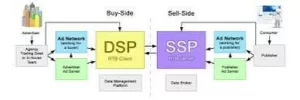What Is Programmatic Advertising & How It Can Benefit Your Business?
Written by Amelia Crisp
Stack Adapt is the programmatic platform that we use here at Talking Stick Digital. It is a self-serving advertising platform that is used for distributing and promoting content using data-driven audience targeting. It allows us to create a range of ad formats for different platforms including display, native, video, tv adverts and more!
Platforms such as Stack Adapt, are able to collect third-party data segments to target audiences by location, industry, job functions and titles to allow the adverts to connect with the correct people for their client’s business goals. Stack Adapt also has third-party software integrated within its own platform to gather such data, such as Bombora.
Due to its large network, powerful targeting capabilities and its range of ad formats, Stack Adapt is able to push adverts in front of users while they are browsing the internet on either desktop or mobile devices on over a hundred thousand trusted websites.
Before programmatic advertising, this process had to be done manually, making the process expensive and unreliable, with programmatic, this process is now streamlined making it more efficient. As a result, did you know: marketers already are putting more than 50% of their media budget into programmatic advertising?
So, lets get into it!
What is programmatic advertising?
Programmatic advertising is a sophisticated, data-driven, and automated method of buying and placing digital advertisements. Unlike traditional ad buying, which involves manual negotiations and ad placement, programmatic advertising relies on algorithms and real-time bidding to streamline the process. It’s like having a digital marketing expert who can make split-second decisions to ensure your ads reach the right audience at the right time.

How does programmatic advertising work?
Data Collection & Audience Segmentation
The process begins with the collection of vast amounts of data from various sources. This data includes user behaviour, demographics, interests, and more. It can be obtained through cookies, website visits, mobile apps, and other tracking methods.
The data management platforms (DMP’s) organise and analyse this data, and segment it into specific groups based on shared characteristics or behaviours
Ad inventory & publishers:
Websites and mobile apps offer ad space, which is known as ad inventory. This inventory can include display ads, video ads, native ads, and more.
Publishers are the owners of the websites and apps that provide this space, and they make it available by placing it through another platform – supply-side platform (SSP) which is then signals to the programmatic platform.
Advertisers and demand-side platforms (DSPs)
Advertisers that are looking to promote their product use demand-side platforms to manage and optimise their programmatic advertising campaigns, and the DSPs connect to the different sources to access the potential ad inventory.
Real Time Bidding (RTB)
When a user goes onto a site, the impression becomes available to sell and advertisers who are using demand-side platforms are using real-time auctions to bid on this one impression. Each impression is valued based on various factors, such as the user data, the placement and their targeting criteria.
Once the DSP submits the bid on the advertiser’s behalf, the highest bidder wins and has their ad displayed to the user. This whole process happens within milliseconds as the page or app loads.
Ad serving
Once the ad is selected through the auction, the ad is served to the user in the designated ad placement in the chosen format, whether that be a video, display, banner or other.
User Interaction & Tracking
If the user engages with the ad by clicking, watching or taking another action to the desired goal, this data is collected and used for optimisation by the advertiser. Data such as time spent on the site, what pages they visited, items they added to cart, how they engaged with the website, and conversions that took place after certain action. First-party data is one of the most valuable types of data, as it gives the advertisers first-hand information about our audiences behaviours.
Advertisers then collect this data to measure the success of their campaigns based on their clients goals.
Campaign Optimisation
Advertisers and the demand-side platform continuously monitor the campaign performance and based on that performance, adjustments are made in real time such as changing bidding strategies. Targeting criteria, placements and overall creatives.

How you can thrive with programmatic advertising:
Set clear goals and objectives:
Understand your target audience thoroughly. Collect and analyse data to identify their demographics, interests, behaviours, and online habits. This information will help you create highly targeted campaigns.
Optimise your creatives:
Craft compelling and relevant ad creatives that resonate with your audience. Many programmatic platforms allow for dynamic and personalized ad content, which can improve engagement and conversion rates.
Have a decent budget:
When using programmatic advertising, its recommended to have a lifetime campaign budget of a minimum of £300 to give it enough budget to do its job, depending on performance you can scale up in terms of spend. We’ve found the best results when giving the platform £50 a day or more, but of course this depends on client budget constraints.
A/B Testing:
Experiment with different ad creatives, messaging, and strategies. Conduct A/B tests to determine what resonates best with your audience and refine your approach accordingly.
Use a range of ad format types:
Using a range of ad formats and dimensions allows your content to fit in more places meaning more people in your audience will see it on their desktop or mobile, adding a cross channel strategy of implementing your ad on different platforms such as websites, apps, podcasts, out of home and more!
What are the different types of ad formats?
Native: Interesting, entertaining and educational creatives in familiar environments such as editorial sites ie. The Independent, The Sun or The Daily Mail
Display: Interactive content such as videos or Gifs that appear on different websites such as emoji.com, Grammarly etc
Video: Connect with your audience with appealing and emotional content, this helps with brand building
Audio: Speak to your audience during time away from their screen, such as on the radio, Spotify or on podcasts
Connected TV: Show your ads on poplar streaming apps such as Roku or Apple TV
In-Game: Reach your engaged audience during gameplay with intrusive ads that are right in front of the user.
Digital out of home (DOOH): Connect with your audience when they are on the move, such as going up the stairs at the tube or above the user when they are on the train, on interactive bus stop signs and billboards
What are some examples of programmatic advertising?



In conclusion, programmatic advertising represents a dynamic shift in the way businesses promote their products and services online. By leveraging data and automation, it enables advertisers to target their audience with precision, optimise campaigns in real-time, and achieve a higher return on investment. Consider incorporating programmatic advertising into your marketing strategy to stay competitive in today’s digital landscape and unlock its vast potential for your business, contact us today for more information on how we can use programmatic in your business and marketing strategy.

